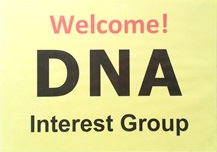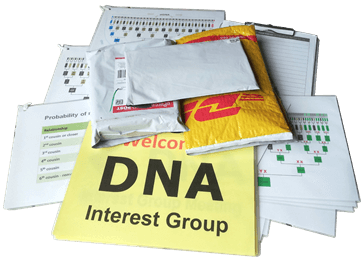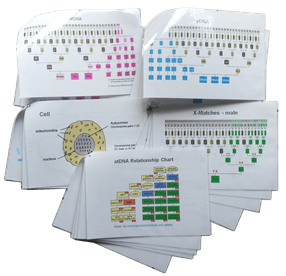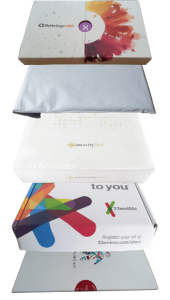Thousands of genealogists have tested their DNA for family history purposes, but from my experience it seems that many are not members of DNA Interest Groups (DIGs) or even family history societies – they are going it alone, or getting their support entirely online.
These genetic genies are missing out on valuable collaboration and interaction with fellow DNA testers, and family history societies are missing the benefits of having genetic genealogy skills in their membership base, as well as the opportunity to boost their membership numbers through the lure of this exciting technology.
All family history societies (FHS) should have their own DNA Interest Group, as DNA testing has now become an essential tool for genealogical research.

A DNA Interest Group (DIG) is a very simple service for a traditional family history society to offer its members, and one that can provide encouragement, know-how, support and collaboration at each step of the genetic genealogy experience.
A DIG only needs one person to start it off, and to invite one or two others to get it going. Once a DIG is established, awareness spreads among existing FHS members who have not considered DNA testing before. They will feel the ‘buzz’ of excitement, hear the success stories, be inquisitive, gradually become interested themselves and appreciate the support provided.
 DIGs have the potential to turnaround declining membership numbers by attracting new members from the community – both long-time genealogists as well as younger and more tech-savvy members, some of whom will need to learn traditional research methods to find evidence to support their genetic genealogy discoveries.
DIGs have the potential to turnaround declining membership numbers by attracting new members from the community – both long-time genealogists as well as younger and more tech-savvy members, some of whom will need to learn traditional research methods to find evidence to support their genetic genealogy discoveries.
Young people are often attracted to DNA testing purely for the ethnicity predictions, and some of them will eventually become curious about the biological cousins they find in their results – triggering an interest in genealogical research.
There is no magic formula, but there are many options and so much potential. When establishing your new DIG, customise it to suit your group’s particular requirements, experience and circumstances. Many variables will affect your ultimate format and structure – including location, population, demographics, accessibility, membership size, physical resources, availability of technology, leader’s availability and experience, and more.
Your group will evolve over time, due to organic growth, participants’ improved knowledge, and by experimenting with different formats to discover what works best for your group.
When planning, consider the original intention of forming your DNA Interest Group:
 Is it to cater for existing members only, as just another special interest group? For those already working with DNA as a research tool? To encourage other members to explore DNA testing and recognise the importance of genetic genealogy as a tool?
Is it to cater for existing members only, as just another special interest group? For those already working with DNA as a research tool? To encourage other members to explore DNA testing and recognise the importance of genetic genealogy as a tool?Consider the experience levels of the leader(s) and the expected participants, and to what levels your group should cater… all or just some? Most groups will start with a focus on beginners and those with a basic knowledge of genetic genealogy – usually a handful of people who have already done a test and want to learn more about using or understanding their results.
As group members gain experience and the group size grows over time, sub-groups might be considered for those working at the intermediate and more advanced levels of analysis, or to focus on particular areas of interest such as Y-DNA & SNP testing, project administration, adoption/unknown parentage (eg. tree mirroring techniques), ethnic origins, population science, ancient DNA, endogamy, chromosome mapping, or health aspects.
If you have a larger group, survey prospective members (eg. try SurveyMonkey) to gauge their levels of knowledge and experience. Find out if they have already tested, how many kits, which test types, which company, and their background knowledge of genetic genealogy. It is likely that the majority will be enthusiastic beginners, but you may get responses from some experienced members who could help co-lead and/or take on a sub-group.
Beginners are incredibly important, so should not be turned away or ignored. As your group evolves, allocate an experienced and friendly person to attend to newcomers and beginners each session. If your DIG is large, don’t turn participants away, but allocate different groups to different rooms or schedule them on different days so no groups or individuals miss out. Participants can progress to the next level groups as they learn over time, and even the convenors can swap groups if desired.
DNA success stories and confirmation of biological relatives will occur at any experience level, and will happen more often as more people test.
Ask your prospective members for their preferences. I recommend monthly meetings to start with, and adjust the frequency if needed – by regularly consulting your group members. My first DIG was bi-monthly, which was clearly not frequent enough for the first 20+ beginners who were ordering tests, receiving results, and who needed interim guidance through those early stages. Our DIG continues to meet monthly – alternating between a structured meeting and a casual open format session that welcomes newcomers from the community. Impromptu, ad hoc and online meetings are also easy and effective to provide support in-between scheduled meeting dates.
I recommend at least 2 hours for structured meetings, or longer if required and the participants agree. Time is needed for any presentations, group discussion and individual assistance. We normally end up with small groups staying back past the scheduled finish time, but that is entirely optional. Allow for breaks if necessary, with access to kitchen and utilities. Casual drop-in sessions can be shorter if desired.
Use your judgment. Meeting sizes will depend on society size, levels of interest, frequency, whether you have sub-groups, your meeting room size, scheduling practicalities, whether someone is presenting or you are having group discussions or providing individual or small-group assistance. Split very large groups into sub-groups based on experience levels, as mentioned above, so no-one is turned away.
You might prefer to hold a pre-booked and tightly-structured meeting, or if your group is smaller and more casual and you’d like to encourage inquisitive newcomers from the community to call in (ie. potential new members), you might consider a more casual drop-in format. I find our casual drop-in DNA clinics are a good way to attract new members from the public. Online meetings of group members via GoToMeeting, Skype or Zoom are another format that is very practical, particularly in-between scheduled face-to-face meetings.
You may or may not need an agenda, depending on the size and structure of your group. If you have structured meetings that include presentations, you could have an agenda and project it onto your wall/screen or hand around a printed copy at the beginning of the meeting so attendees know what to expect. The agenda may be as brief as a welcome to all and a list of any presentations or special topics, time for group discussion and individual assistance, and finish time. Casual sessions shouldn’t necessitate an agenda, as flexibility is essential when you don’t know who might attend and the session is mostly discussion-based, either for individuals or small groups. Allow plenty of time for discussion, questions & answers, success stories and suggested topics for the next meeting.
Keep an attendee list and recommend that new attendees add their name and email address to your DIG newsletter mailing list for group correspondence, meeting reminders, future topic suggestions, industry news, sale announcements, etc. Be welcoming to new members – greet them, be friendly, provide them with a stick-on name tag or at least make sure you and other regular members wear a name tag so new members don’t have too many names to remember.
Familiarise new attendees with the building layout, including library, kitchen, restrooms and exits. Make it easy for them to be comfortable and participate. If your meeting room is in an obscure location, allocate someone to meet and guide newcomers, or use some simple laminated signs with arrows directing the way.

Basic physical requirements include:
If you have access to a large screen TV or projector that you can connect a laptop to, take advantage of it for presentations & slideshows, and also use it when appropriate to demonstrate practical things you are discussing or helping members with, eg. reviewing results, looking at DNA project pages, how to download raw data, how to upload to or utilise tools and reports on GEDmatch, review popular websites, etc. Most attendees say they learn so much while watching others being assisted, and the large view makes that easy for all (NB: always ask permission before displaying someone’s results for others to view).
Make sure you are familiar with the Genetic Genealogy Standards. Respect the privacy of your attendees personal information and that of their matches. Ask permission before displaying or sharing any member’s personal results with other attendees (and ask permission from your own family members before sharing their results). For larger groups and/or public sessions, use a prepared slideshow instead of a live demonstration. When preparing slideshows, always obscure all personal details of testers or matches, eg. names, usernames, email addresses, profile images. It is very simple to use the Snipping Tool or the Awesome Screenshot browser plugin to blur personal information.
At the meeting close, ask for suggestions for future topics, and ask if anyone would like to share their results or experience at the next meeting.
If you have any content (slides, presentations, handouts) that can be shared, tell the participants where to find the links on your FHS website.
At the beginning of each meeting or after any presentations, invite attendees to give a very brief update of their status/progress so you know what might need to be covered later in that meeting. Have they ordered new tests or received new results? Do they need help deciding who else to test or with developing a testing plan or hypothesis? Do they require assistance with ordering, online accounts or other technical issues? Have they experimented with new tools since the previous meeting? Do they have any success stories that they’d like to share with the group? Also enquire as to the level of experience of newcomers. This brief assessment can be useful for planning the rest of the meeting. If there are enough beginners, a second convenor might take them to another area leaving the more experienced users to continue with their discussions.
Beginners
Make up a ‘DIG Kit’ to use with beginners:
DIG Kit suggested contents:

Group leaders will initially present on a variety of genetic genealogy topics to get the DIG underway. Once they get their DNA test results back, encourage other group members to speak too. Invite them to present their DNA results and/or any discoveries, experiences, issues, successes, favourite features or search tools. They may be nervous about doing it for the first time, but with encouragement and some support preparing their content beforehand, it will be a great experience for them and they may continue to present regularly. Provide a suggested outline or template relevant to their topic to make it easier for them to get started. DIG members really do enjoy seeing and hearing about other people’s DNA results and experiences. They learn how others might do things a bit differently, they learn new tricks, tips and tools, and they can relate some parts of it to their own results and family situations.
Set a time limit for short talks, for example 10 minutes each, or longer talks for up to 30 minutes each, depending on the nature of the content. 5 minute flash talks could be used in between other agenda items, and as group members become accustomed to these, they may become good at impromptu mini-presentations to support or provide demonstrations to others.
Also consider inviting DNA speakers to present, perhaps via Skype, Zoom or GoToMeeting.

There never seems to be a shortage of ideas for presentation and discussion topics on DNA testing.
Suggestions include:
Ask your attendees what topics they’d like to hear or discuss at future meetings.
Interest group meeting charges will depend on the individual FHS, their financial situation, the demographics of their region, their membership base, and any existing fee policies for special interest groups. Some groups may offer this service free to members or charge a gold coin donation. Some groups restrict special interest groups to financial members. Other groups charge a small fee for members and slightly more for non-members. If a non-member joins up on the day, offer to reduce their membership fee by any fee they paid to attend that session. If you have to pay for your meeting room hire, you may need to charge a small fee to recover those costs.
Finding new members for your DNA Interest Group won’t be too difficult if you share your genetic genealogy experiences and success stories within your FHS and the wider community.
Take advantage of some of the following ideas to promote your group and genetic genealogy in general:
 Advertise your future DIG meeting dates in all your regular FHS publications (eg. newsletter, journal) and post meeting dates on your website calendar (keep it up-to-date).
Advertise your future DIG meeting dates in all your regular FHS publications (eg. newsletter, journal) and post meeting dates on your website calendar (keep it up-to-date).The biggest challenge with DIGs is managing members who are at different stages of learning. We welcome new members every time we open the doors – and we get them, so we have to be flexible enough to cater for beginners as well as the more experienced members, all at the same time. DIG groups evolve over time according to the experiences and interests of the members. Be flexible, provide value, and make joining and contributing easy and satisfying.
Most of the genetic genealogy experience is managed online – from ordering DNA test kits, receiving results, online accounts, notifications, customer service, tools, research & education, forums, conferences, family trees and correspondence with relatives – so it can be a pleasure to get offline occasionally and share your interest via face-to-face contact with a group of like-minded people. The benefits of sharing and collaboration are worth it.
So if your family history society doesn’t yet host its own DNA Interest Group, why not consider getting one started? If you don’t belong to your local family history society, approach them and ask if they’ll support the establishment of a DIG if you join. All you need is one or two interested people to arrange a time and place, and advertise it – and others will come. Even if you don’t think you need a DIG yourself, sharing your genetic genealogy knowledge through a group will encourage many more people to test their DNA far sooner than they otherwise might – and consider that one of them just might test a relative who knocks down one of your research brick walls!